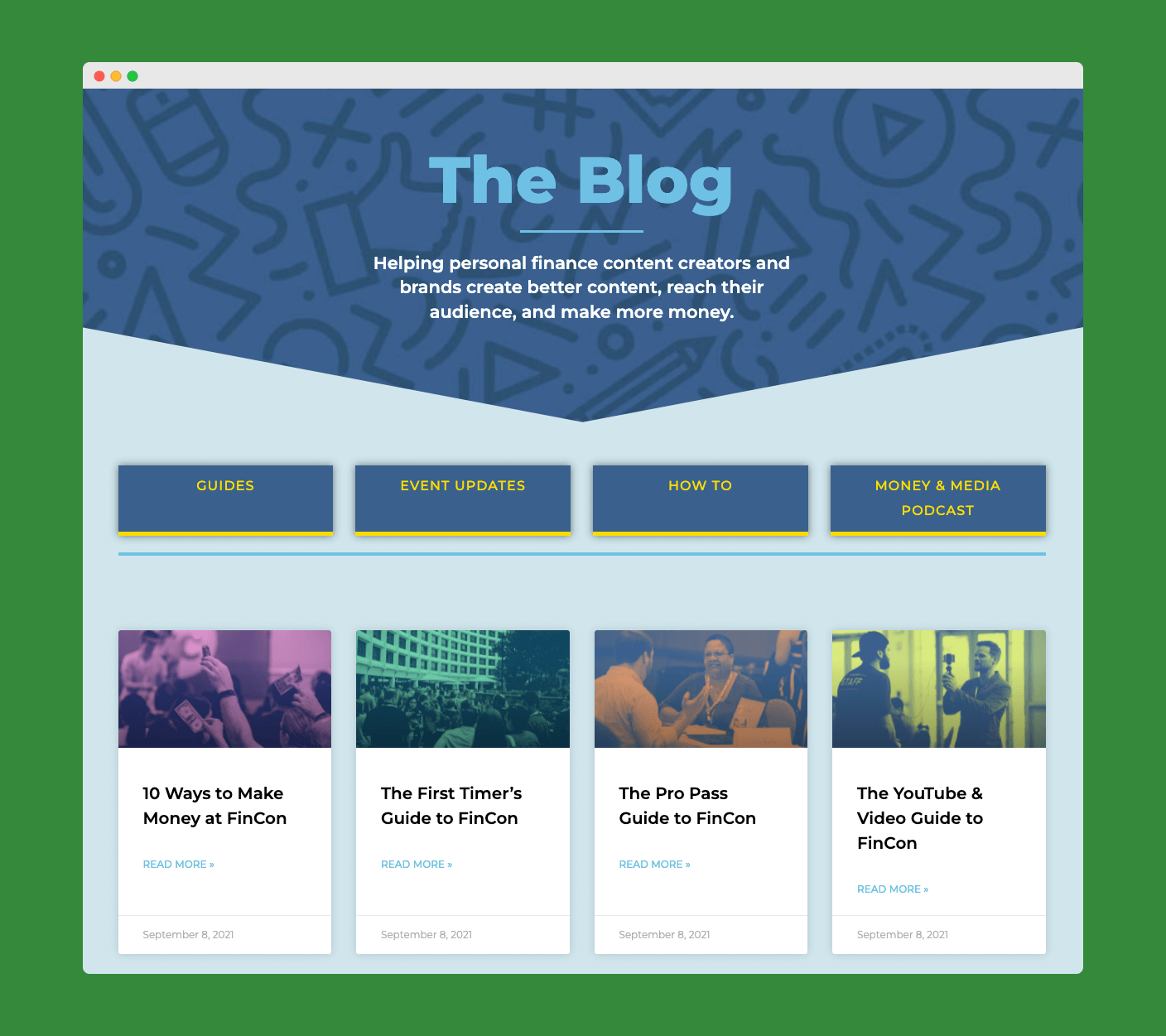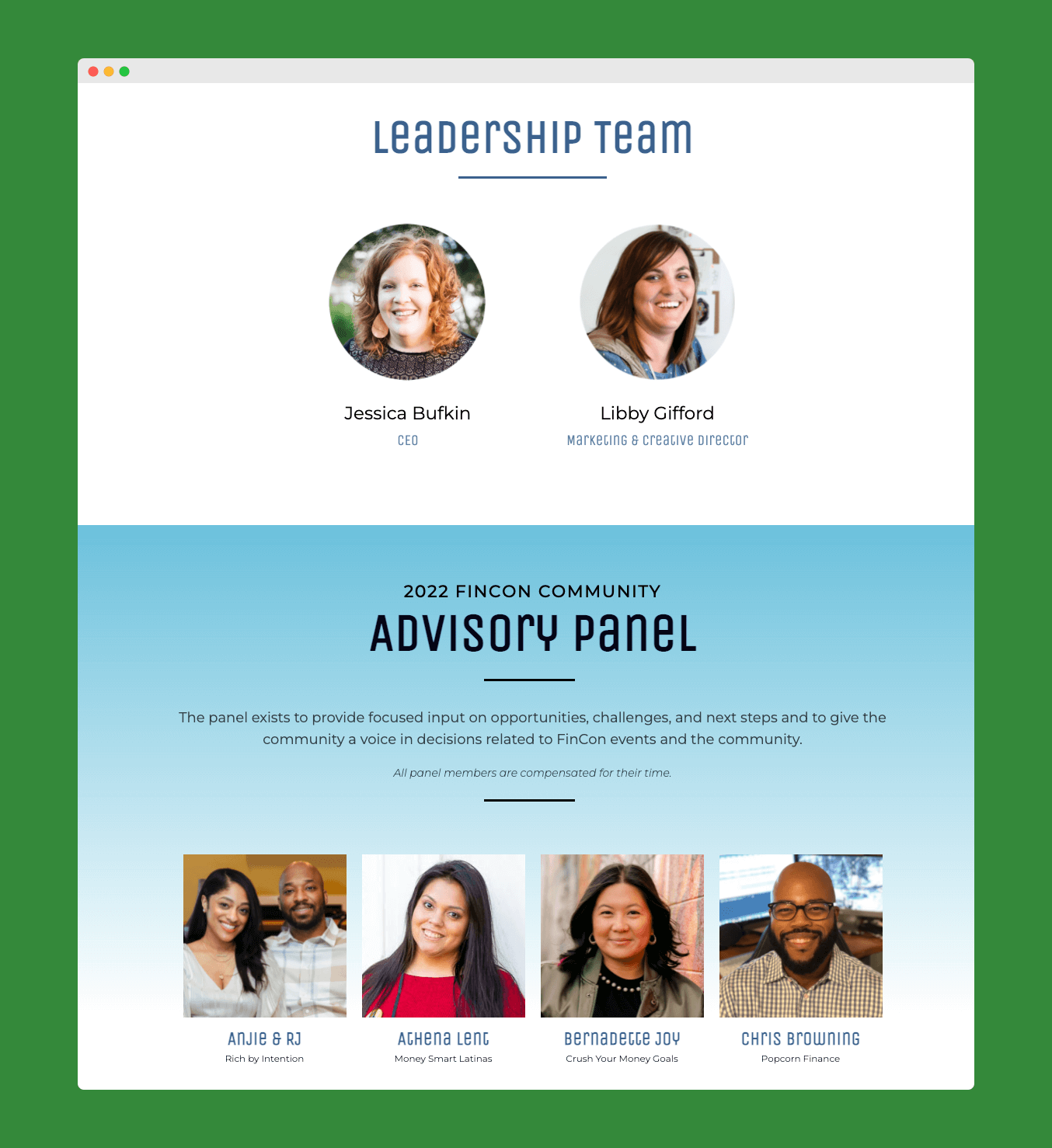7 Ways to Grow Your Business | My $0 to $1 Million Dollar Story
Looking for ways to grow your business? In year one, my conference business had a total revenue of $89,000 (see my first profit and loss statement here).
Just seven years later, the revenue had grown to over $1,000,000.
The team and I did this without receiving investment money, without taking a loan, and without spending money on marketing.
We’ve no doubt benefited from an expanding market (more bloggers, podcasters, etc) and a rising economy (affecting our exhibitor and sponsor numbers), but I like to think we made some smart moves to affect growth above the market growth rates.
Other conferences have also thrived in this environment, but some have floundered and are no longer around. Here are 7 ways to grow your business:
Table of Contents
Below, I’ll share more on how we grew, and share some other examples and resources so that you can take steps to grow your small business too.
1. Make the Product Better
The best way to grow your business is by improving your product or service. A better product can make your current customers happier and can also attract more people to your product because of the added benefit. Double whammy!
Make sure you are constantly evaluating your business to ensure you’re offering something special. Ask yourself routinely, “are we getting better?” To get better you need to listen to your customers.
Listening to your customers is hard. It’s easier to make the quick sale and move on. I do this a lot. But if we can take the time to get to know the customer, spend time with them, and ask them what they think, they will tell us all we need to know.
“There is only one boss. The customer.” – Sam Walton
Most people actually want the business to succeed. They want to help you make the experience better for them and others. If you turn away, they will sense it and take their business elsewhere.
For me, better meant a nicer location to hold my conference, higher-quality speakers, richer content from my speakers, more exciting parties, more networking opportunities, more helpful customer service, and clearer communication.
These things helped to grow the event, and ultimately, the business.
How You Can Apply This
Some resources for learning to listen to your customer: Ryan Levesque’s book Ask., the online survey tool SurveyMonkey.com, and these social tools for listening listed by Social Media Examiner.
You can also get better by staying on top of new options or innovations in your industry. This can be as simple as subscribing to your industry blog or podcast. I follow Event Manager Blog and I have my team review their articles as well.
Being the first to adopt new strategies and tools to deliver your product or service can quickly separate you from your competition.
So what is “better?”
You need to decide what’s better for your customers after listening to them. They’ll let you know.
How can you make your business better?
2. Innovate with New Products
To grow your business, you can also focus on creating another offering, or multiple new offerings. This also has a double whammy effect of pleasing your current customers (“Yay, more choice!”) and attracting new customers (“Hey, I didn’t know they did that!”).
One important caveat: the new offers don’t have to be revolutionary. They can simply be little iterations on the standard. You’ll notice I haven’t created a whole new second conference. I’ve made small changes.
New add-on offerings we created in our conference business in the first five years:
- We expanded our sponsorship deck to include more sponsored elements.
- We moved to an expo hall format (10’x10′ booths) vs tables in the foyer.
- We created new education tracks: for advisors and podcasters.
- We created a second-tier ticket (the “Pro Pass”) to serve the more professionally-minded attendee.
- We created a more intimate event before the conference.
Not all of this worked. Things on the sponsor deck went unsold, some booths didn’t sell, and we never made a profit on pre-events. But overall, these little iterations have helped to expand our business and bottom line.
Of course, if I were bolder, I would expand into a second event. You can bet I’m constantly evaluating this idea.

Bonus (semi-related) Idea
One subtle change I made after year one of my business was to change the name of the event from The Financial Blogger Conference to just Fincon. I did this because more than just bloggers showed up.
Sure, bloggers are our core customer. But advisors, podcasters, journalist were all at the first event. My gut told me to broaden the tent and that has naturally attracted more customers from outside of our original intended audience.
How You Can Apply This
Let’s say you are a freelance writer (like my friend Jason Steele). You mostly write articles for blogs and websites. This same customer–the blog owner–might also want to create a course or transcribe podcast episodes.
You could start offering these additional services (at a higher rate–hey!) and do more for your current customer. These new offerings could also attract podcasters to your business for the first time.
You have to be careful here, of course. You don’t want to “out punt the coverage” as they say. You still need to be able to serve your core customer effectively, keep quality high, and maintain a healthy team. But if you can manage it, expanding can be huge for growth.
Related: 7 Business Ideas That Scale Efficiently
So how are you going to grow? Small little iterative offerings like me? Or will you go big and double your business overnight with a completely revolutionary offer?
3. Create Content & Social Media
Another way to grow your business is by creating or sharing educational, inspiring, or entertaining content geared toward your ideal customer.
I’m a content marketer. Naturally, I turned to content as my first big push into external facing marketing.
Instead of doing all the content myself, however, I turned to my customers to help create it–a mix of paid & user-generated.
Blog
The blog was how I initially communicated event updates. Shortly after the first event, I invited my customers to write for the blog if they wanted. And I hired a popular freelance writer from our community to help me build out the content.
She produced a mix of how-to pieces that we felt our community would like and share, like this piece on writing guest posts for other blogs.
She also produced community roundups like this one on remaining anonymous as a blogger.
Finally, I started repurposing the videos of talks from the conference and turning them into blog posts. I love this type of content, because it’s free to repurpose, it helps the customer, and it gives them a sense of what it’s like to be at the event.
So that was the initial approach to content in year one.

Magazine
Leading up to the second event we decided to create a magazine that could double as the conference agenda/guide. I borrowed this idea from another event who uses this magazine as a promotional mailer as well.
The articles in the magazine were produced by the speakers, sponsors, and attendees of the upcoming event. I don’t want to pretend like this was an easy thing to produce. It’s a bear of a project and my assistant event planner probably spent way too much time working on this.
But here it is in all its glory: Fincon Magazine
Podcast
The next big content play for us was to create a podcast. Initially, the podcast was called the financial blogger podcast. I simply interviewed successful financial bloggers and got them to share their success story.
A year later we re-branded the show to The Money & Media Podcast in an effort to broaden the appeal. I brought in a co-host–a popular podcaster in our industry–and we were able to produce around ten shows leading up to the conference.
Twitter is great for our business. One, because we’re an event and hashtags and events just go hand-in-hand. And two, I have a B2B offering. Other blog owners are on Twitter and it’s where they hang out each day for a bit of community and news.
We ask each new attendee what their Twitter handle is and we follow them from our brand account. We also participate in a few Twitter chats before the event.
How You Can Apply This
One of the best ways to do this is to turn the focus on your successful customers and get them to share what’s making them successful. This could come in the form of an interview produced for Youtube/iTunes or a simple text transcript for your blog.
Another method of content creation I like is to document your journey as a company. This type of content can be super helpful and entertaining for customers and can also help to define your brand in your customer’s mind. It’s also great for getting media coverage.
Finally, you could create content that answers your customers burning questions and concerns. You likely hear the same questions over and over; produce some great content by answering these questions in the form of blog posts, social media posts, podcast, etc.
You don’t have to do it all like us (we are a content marketing event, after all). Start small and expand from there.
Related: How to Start a Business with No Money
What content could you be making regularly to grow your business?
4. Create (or Foster) a Community
They have a saying in the conference business, “people come to your event for the first time for the speakers, but they come back for the community.”
True, a great way to create loyalty and stickiness to your brand is to create (or foster) a community environment where your customers have more than just your product to come back for. They come back to see their friends.
Letting the Community Be Part of the Process
In the case of my conference business, a distinct community (the personal finance blog-o-sphere) existed before I held my first conference.
What I gave this community, however, was a more personal, intimate place to hang out together in real life.
As much as possible, I allowed (and continue to allow) this community to help me actually build the event. I took surveys and asked for feedback along the way.
I tapped influential members of the community to lead key aspects of the event.
I brought in existing community elements, like the Plutus Awards and our mentoring program, to help make my event a better experience.
Encouraging Community Outside of the FinCon Annual Event
But I didn’t stop there. I did more to foster a sense of community with my customers. With the help of a community member, I started a Facebook Group where attendees could talk with each other throughout the year.
I also encouraged local meetups throughout the year so that community members could meet with people more regularly in their city.
We take this community-building approach with us with whatever we do.
For instance, when we exhibit at other conferences, we make the booth all about the community members–we invite them into the booth to make content (on their podcasts, for instance) and meet up with each other.

How You Can Apply This
Like me, your business may be serving a community that already exists. In that case, your job is to recognize that group and find ways to foster the relationships already in place.
For instance, a local shoe store might want to contact the local running clubs and offer their space as a place for running groups to meet up before or after their runs for coffee & stretching in a comfortable environment.
If no distinct community exists around your product or service, then you have the opportunity to create one yourself.
In the case of the shoe store, if no running clubs exist, create one. You could also start up a couple of local fun runs and host registration and packet pick up in-store.
From then on, your shoe store isn’t just another shoe store, it’s where I go to see my friends on Saturday before our training run, and where I meet my running coach next month to register for the upcoming race.
Some ways you might be able to create or foster community in your business:
- Host an event or (even better) a series of events.
- Partner with an influential community member.
- Form a club or meet up group.
- Create a Facebook Group, forum, and/or community hashtag.
How will you create a community?
5. Charge More
Here’s an easy one. Just charge more of your product or service.
Okay, not so easy. This doesn’t automatically grow your business, but it could. You could be underpriced, and the same set of customers might be willing to pay more for what you offer.
They might not though. A price increase could end up hurting you.
Price Testing
Test price increases on a subset of your customers first to see how they react.
If you see no dip in sales then you know you can raise prices across the board. Keep raising prices until you hit the sweet spot.

Loyalty Pricing
One way to raise prices without affecting your existing customers is to maintain loyalty pricing. You only raise prices on new customers. This is the approach I took.
I have one of the most affordable marketing conferences around today. In my first year, I charged just $99 to attend, regardless of when you signed up! Prices have slowly crept up since that first year to keep up with inflation and an improved, longer event.
Still, I offer a <$200 ticket to my returning attendees (if they sign up for the next conference while at the event).
For everyone else, they have to pay more in line with the pricing of other events. Our full pricing is around $500, but it’s got a graduated discount the further you buy from the event date.
Related: 8 Service Business Examples
How You Can Apply This
If you’re looking for ways to enhance the perceived value of your products or services, this piece from QuickSprout is chocked full of great ideas.
I would encourage you to read the whole piece but here is a summary of the strategies that it discusses.
Limit Your Product Lines
Perhaps you’ve heard of the famous jam experiment that two psychologists completed.
Over the course of two separate 5-hour experimental periods, shoppers passed by a table with either six jams or 24 jams. Nearly 30% of customers who visited the limited-choice table purchased a jar of jam while only 3% of customers who stopped at the extensive-choice table made a purchase.
This shows that more is not always better. Creating new products can definitely be a great way to stimulate growth. But don’t overdo it. Could I offer eight different variations of a FinCon ticket or six separate FinCon events throughout the year? Sure.
But at some point, I would begin to see diminishing returns on my efforts to create a smorgasbord of options.
Limiting Supply
Another idea you can try if you want to charge more is limiting your supply or how long a particular product will be available. Coffee shops use this strategy to perfection with their seasonal drinks.
In a way, I use this strategy as well by limiting the timeframe that discounted tickets are available.
Avoid Discounting Your Product or Service Too Often
If your customer knows that you regularly have sales or send coupons, they may be less likely to ever be willing to pay full price.
If you want to charge more for your product or services, one of the simplest ways may just be to limit how often it “goes on sale.”
What can you do to add value to your product to justify a price increase?
6. Hire a Talented Team
If you want to grow, it helps to have talented people around you to bring fresh ideas and execute on them.
Identify the weaknesses in your skillset (and also the areas in your business that you shouldn’t be working on) and hire accordingly. Find people who are smarter and more talented than you in those areas and bring them in.
Why A Talented Team Matters
Solid team members help to grow your business in a couple of ways.
First, they take things off your hands, freeing you up to plan the growth of your business.
Second, they add value where there was none.

Finding Talent
You can find talent to add to your team from within your community, or you could take it to open market and hire that way.
You could hire talent on a contract, part-time, or full-time. Although a mix of all might be best.
In my case, I hired four contractors before my first event. Someone to do the overall event coordination, an a/v coordinator, a salesperson, and someone to build out all of the visuals.
I hired people I trusted and who I knew were loyal to me (all were friends and three were working with me at my other business) and would serve the community the way I wanted them to be served.
How You Can Apply This
If you’re looking to build your team, here are some ideas that can help you find top talent.
Encourage employee referrals
Lever says that nearly half of all job hires are proactively sourced or referred. Reach out to your current employees and ask for suggestions.
You could also create an employee referral program that includes bonuses for referrals that end up getting hired.
Use Job Boards
If you aren’t able to find the right fit for your business through referrals, you can take advantage of one of the many online job boards available today. ZipRecruiter, LinkedIn, Monster, and Indeed are a few of the most popular, but there are many more.
One of the nice things about ZipRecruiter is that it sends your job posting to over 100+ job sites at once. And their matching technology is pretty amazing. They say that 80% of employers who post a job on ZipRecruiter get a quality candidate through the site within the first day.
Create an Attractive “Careers page” on Your Site
Look at your Careers page as a way to showcase your company’s culture. Talk about what makes your business unique, the amazing work that your team is doing, and why you’re a fun place to work.
Don’t just use words. Use photos and videos too. And huge bonus if you can include employee testimonials!
Related: 8 Small Business Mistakes to Avoid
Would your business grow if you had more talent?
7. Seek Partnerships (or Acquisitions)
My final suggestion for growth is partnerships and acquisitions.
My number one rule for partnerships in business: make sure they are easy to get out of. Things change all the time and you want to be able to move on if things don’t work out.
Partnerships
Partnerships can be tricky. Especially if you enjoy having complete control over all aspects of your customer’s experience. You’d want them to experience the same level of care that you give them. And you’d want to be able to meet the expectations of their customers.
In some instances, I’ve partnered with organizations whose members ended up being disappointed in us because we didn’t offer the level of service they are accustomed to. And vice versa. Sometimes we pass customers over to partners and their expectations aren’t met.
I already mentioned a couple of my partnerships–the award show and the mentoring program. I also partnered with an:
- Association of young finance advisors who helped us build out a special new track at the event and created their own pre-conference event, bringing in many new advisor attendees
- Online community forum of personal finance bloggers who helped us connect with new, up-and-coming bloggers who might be interested in our event
- Online community and event company geared toward female bloggers who ended up taking over our pre-conference camp/mastermind experience and bringing in more female bloggers
These partnerships aren’t always easy to manage, but the net effect is positive for the results of the event–more attendees and a better experience for those attendees.
Acquisitions
I’ve yet to acquire any other businesses, so I can’t speak personally to growth by acquisition.
However, it would make sense for us to consider an acquisition of other conferences and tradeshows as a way to rapidly grow our business. We do this work already for our own event and our team could easily expand to run other events.
Acquiring a business can be fraught with peril if you’re not careful. Here are a few of the things that can go wrong.
- You start chasing deals instead of focusing on your business.
- You’re not willing to make the tough decisions
- You overestimate the synergy that will be created between the two companies
I think that last point is especially important. When two companies join forces, their results can be more OR less than the sum total of both parts, depending on how well they work together.
How You Can Apply This
Whether you’re looking to partner or acquire another business, don’t get consumed with chasing the next deal. Instead, patiently wait to find businesses that align with the values and culture that you’ve established in your own business. Second, look for companies that are already killing it in their own space.
For example, Disney is one company that has mastered the art of acquisitions by identifying companies that are near the top of their industries (think Pixar, Marvel, Star Wars). From an operating standpoint, they basically leave these companies alone. They just lend their financial and branding power.
This is completely different than trying to find a sliding or failing company that you can acquire at a discount. This could save you money, but is also risky.
Don’t be overconfident and assume that you’re the company’s amazing processes and culture will “fix” the inherent problems of a company that you’re thinking about acquiring.
Who can you partner with that will help to grow your business? What business could you acquire to grow your own?
The Bottom Line on Ways to Grow a Business
When it comes to growing your small business, you have a lot of options. You don’t have to do all of these at once, of course. But some combination of the above should help to grow whatever business you are running. If you have to choose one, choose the first one on the list. Just make the product better.
Remember, growing a business can take time. In our case, it took us five years to reach the half a million mark in top-line revenue. We certainly weren’t an overnight success. But we’re continuing to pull each of these growth levers and our business is continuing to grow exponentially.
Which strategy above are you using to grow your business? Are you growing your business in a different way? Share it in the comments below.





